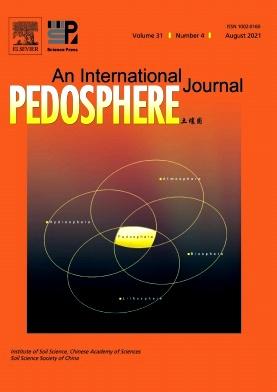丛枝菌根真菌和暗隔内生菌的磷奖励机制:植物碳分配中的协同还是竞争?
IF 7.3
2区 农林科学
Q1 SOIL SCIENCE
引用次数: 0
摘要
暗隔内生菌(DSEs)和丛枝菌根真菌(AMF)联合接种可促进植物生长,但植物与真菌相互作用的机制尚不清楚。为了阐明这种共生关系的本质,探索碳(C)从植物到真菌的运输以及它们之间的营养交换是至关重要的。本研究采用盆栽试验,采用低磷和正常磷两种施肥水平和4种真菌接种处理(不接种、AMF与DSE单接种、AMF与DSE共接种)。利用13C同位素脉冲标记法定量研究了植物向不同真菌的光合碳转移,揭示了植物与真菌之间养分交换的机制。低磷水平下土壤和菌丝体δ13C、土壤C/N、土壤C/P比均高于正常磷水平。低磷水平下,土壤微生物生物量C/P比较低,说明低磷水平有利于土壤C的固定和土壤真菌P的矿化和运输。在低磷水平下,当植物向真菌输送等量的碳时,AMF和DSE对植物的磷奖励显著增加,两种真菌协同促进植物养分吸收和生长。在正常磷水平下,AMF接种植株根系磷含量显著高于DSE接种植株,说明在相同碳吸收量下,AMF对植株磷吸收的贡献大于DSE。此外,植物优先将更多的C分配给AMF。这些发现表明植物C分配和真菌P贡献之间存在源库平衡。总体而言,AMF和DSE通过功能协同策略在低磷水平下给予植物更高的回报。本文章由计算机程序翻译,如有差异,请以英文原文为准。
Phosphorus reward mechanisms of an arbuscular mycorrhizal fungus and a dark septate endophyte to plant carbon allocation: Synergism or competition?
Combined inoculation with dark septate endophytes (DSEs) and arbuscular mycorrhizal fungi (AMF) has been shown to promote plant growth, yet the underlying plant-fungus interaction mechanisms remain unclear. To elucidate the nature of this symbiosis, it is crucial to explore carbon (C) transport from plants to fungi and nutrient exchange between them. In this study, a pot experiment was conducted with two phosphorus (P) fertilization levels (low and normal) and four fungal inoculation treatments (no inoculation, single inoculation of AMF and DSE, and co-inoculation of AMF and DSE). The 13C isotope pulse labeling method was employed to quantify the plant photosynthetic C transfer from plants to different fungi, shedding light on the mechanisms of nutrient exchange between plants and fungi. Soil and mycelium δ13C, soil C/N ratio, and soil C/P ratio were higher at the low P level than at the normal P level. However, soil microbial biomass C/P ratio was lower at the low P level, suggesting that the low P level was beneficial to soil C fixation and soil fungal P mineralization and transport. At the low P level, the P reward to plants from AMF and DSE increased significantly when the plants transferred the same amount of C to the fungi, and the two fungi synergistically promoted plant nutrient uptake and growth. At the normal P level, the root P content was significantly higher in the AMF-inoculated plants than in the DSE-inoculated plants, indicating that AMF contributed more than DSE to plant P uptake with the same amount of C received. Moreover, plants preferentially allocated more C to AMF. These findings indicate the presence of a source-sink balance between plant C allocation and fungal P contribution. Overall, AMF and DSE conferred a higher reward to plants at the low P level through functional synergistic strategies.
求助全文
通过发布文献求助,成功后即可免费获取论文全文。
去求助
来源期刊

Pedosphere
环境科学-土壤科学
CiteScore
11.70
自引率
1.80%
发文量
147
审稿时长
5.0 months
期刊介绍:
PEDOSPHERE—a peer-reviewed international journal published bimonthly in English—welcomes submissions from scientists around the world under a broad scope of topics relevant to timely, high quality original research findings, especially up-to-date achievements and advances in the entire field of soil science studies dealing with environmental science, ecology, agriculture, bioscience, geoscience, forestry, etc. It publishes mainly original research articles as well as some reviews, mini reviews, short communications and special issues.
 求助内容:
求助内容: 应助结果提醒方式:
应助结果提醒方式:


